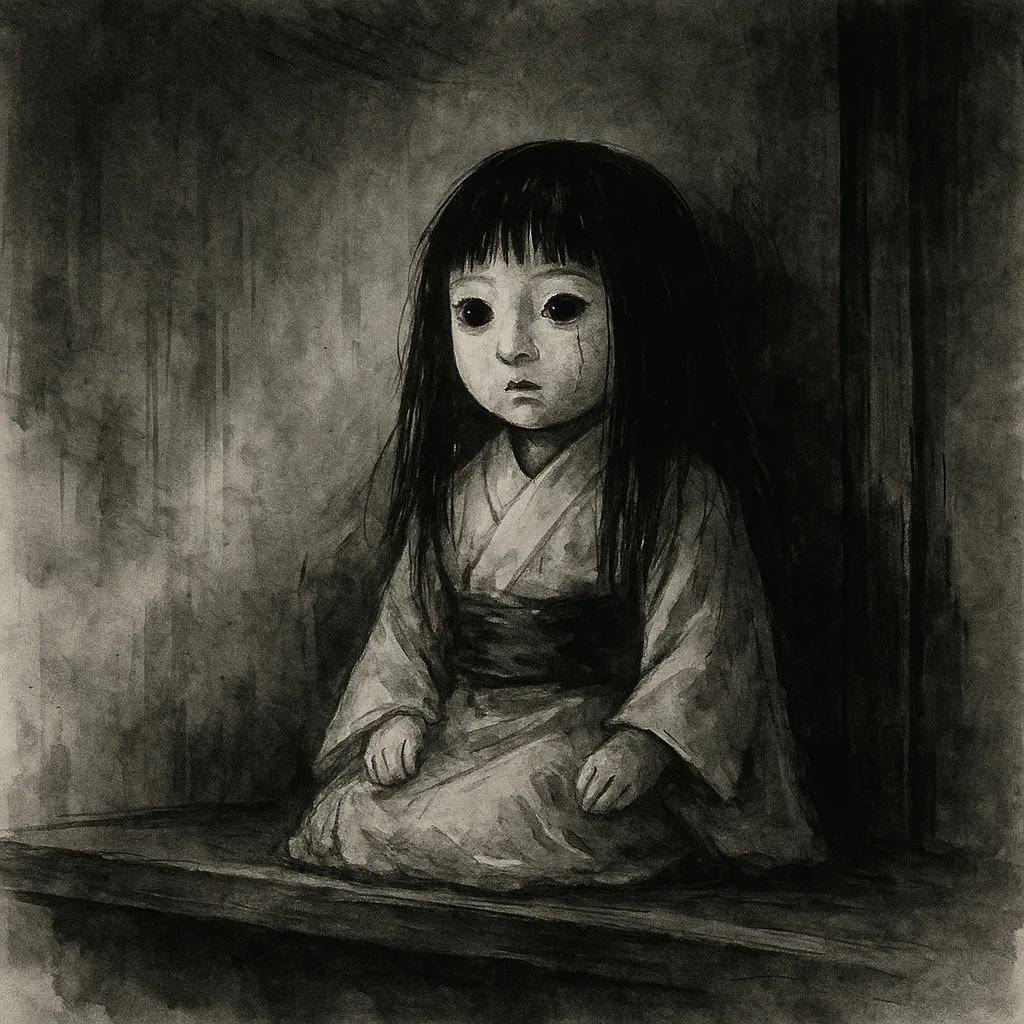Tonight, once again, I shall tell you a strange tale from Japan.
Relax… but do not turn around too quickly.
I am watching just behind you.
Heh, heh, heh…
This is the story of a foreign student in Tokyo, and the doll he brought home from a flea market in Yoyogi Park.
His name was Andrew — a twenty-four-year-old student from London, studying art history at a university in Japan. He had always been fascinated by traditional Japanese crafts and doll-making culture.
One weekend, he visited the flea market in Yoyogi Park with a few friends. In Japan, flea markets are open-air bazaars where people sell antiques, old toys, and forgotten treasures. The atmosphere that day was bright and busy — laughter, chatter, and music all around.
Then, Andrew saw her.
A small Japanese doll in a white kimono. Her black hair fell straight to her shoulders, and her eyes — dark as polished obsidian — seemed almost alive.
“How much is this one?” he asked.
The old woman behind the table smiled, showing her few remaining teeth.
“You have a good eye,” she said softly.
“Take it for free. I don’t want it in my house anymore.”
Andrew laughed, thinking she was joking. He took the doll home and placed it on the shelf above his desk.
“Well then,” he said playfully,
“Welcome to my room.”
That night, the strangeness began.
At first, it was nothing — or so he thought.
A faint tapping near the window.
The curtains moving even though the air conditioner was off.
And in the morning… the doll’s head seemed to be turned slightly,
just enough to make him doubt his memory.
“Maybe an earthquake,” he muttered.
But deep down, he started to wonder:
Was someone — or something — in his room while he slept?
A few nights later, he lay awake in bed.
The air felt thick, heavy with humidity.
His skin was damp, as though the temperature had suddenly risen.
Then he heard it —
a faint, scraping sound from the closet.
Shari… shari… shari…like fabric brushing against the floor.
He gathered his courage, stood up,
and slowly slid the closet door open.
Nothing.
Only shadows —
and the doll, sitting neatly on the shelf inside.
Her hair clung to her cheeks as if wet.
A thin crack ran down her porcelain face.
The next morning, Andrew told a Japanese friend about it.
His friend listened carefully, then frowned.
“That sounds like one of those dolls with hair that grows…
or maybe… a doll with a spirit inside.”
In Japan, there are such stories —
of dolls believed to hold the souls of the dead.
Their hair grows, their presence brings moisture to a room,
and sometimes, misfortune follows.
One famous case is the Okiku doll from Hokkaido.
After its owner — a young girl — passed away,
the doll’s hair began to grow on its own.
Even when priests trimmed it, the hair kept growing back.
Today, the doll is enshrined at Mannenji Temple in Kurisawa, Iwamizawa, Hokkaido,
where monks still care for its ever-growing hair.
Andrew tried to laugh it off,
but he couldn’t.
The humidity in his apartment was getting worse by the day.
The wallpaper began to ripple and peel.
Finally, he decided to return the doll to the flea market.
But when he went back, the old woman was gone.
No one seemed to know who she was.
“There’s never been a seller like that here,”
one of the vendors told him.
Desperate, Andrew carried the doll to a nearby shrine.
The priest listened quietly, then said,
“I can keep it here for you… but remember—
never ask to have it returned.”
Andrew bowed deeply and left without another word.
A few days later,
his room was perfectly dry again.
Everything felt normal.
Except for one thing.
When he checked his phone,
he noticed a photo he didn’t remember taking.
It was a close-up of the doll’s face —
taken in the dark, her glassy eyes staring straight into the lens.
The photo’s location data showed it had been taken inside his apartment.
All around the world,
there are tales of dolls believed to house human souls.
Such stories exist in Japan as well —
and they have been witnessed.
If you ever feel something… from a doll near you,
be careful.
There is a Japanese proverb that says:
“Nothing free comes without a price.”
Like Andrew,
if you take something just because it’s free…
you may be opening a door —
to the uncanny.
Ah, yes… such dreadful things truly do happen in this world.
And so, until our next tale, we must part ways.
May you remain safe… until then. Heh, heh, heh…
Japan Ghost Tales Story Art Collection
Oh… has a cold sweat already begun to break out upon you?
Phantom Joe has prepared a token—an artwork from the“Japan Ghost Tales Story Art Collection.”
Perhaps… you would dare to keep tonight’s tale as a memento?
